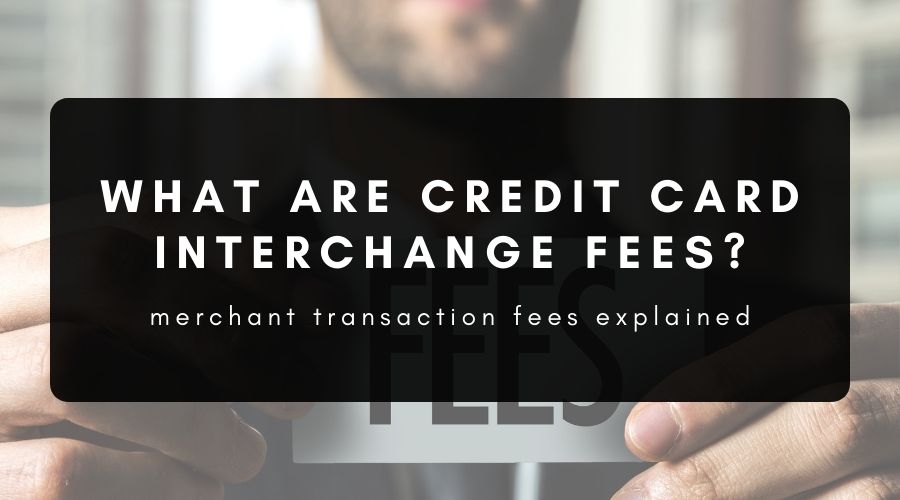Demystifying Interchange fees for credit cards are of course an essential aspect of the payment card system; however, the same thing tends to create much confusion in business and among customers. Often they are labeled interchange fees or, more simply, credit card processing fees. As such, to understand how interchange fees can figure into a transaction’s overall cost structure, understanding what these terms mean can help.

What are Credit Card Interchange Fees?
Interchange fees are fees that a merchant pays the issuing bank for every credit card transaction. Normally, interchange fees are calculated as a percentage of the transaction, plus a fixed fee. A good example of a credit card interchange rate would be 1.5% + $0.10 per transaction. Interchange fees are set to pay for fraud prevention and payment processing expenses, as well as the overhead of maintaining card network infrastructure. Interchange fees are part of a larger fee category called credit card processing fees that also include the payment network fee and the acquirer fee.
Interchange Fee Model
The card networks, like Visa and Mastercard, determine interchange fee structures that vary based on several factors.
- Card Type: Premium credit cards with rewards programs tend to be more expensive at interchange.
- Transaction Type: Interchange fees on in-person transactions are generally less expensive than on online or card-not-present transactions where fraud risk is higher.
- Merchant Category: Interchange fee caps and rates vary by industry. Merchant’s knowledge of this structure helps them optimize payment processing strategies.
Demystifying Interchange Fee Regulations
Many governments have implemented interchange fee regulations to cap interchange fees to protect both businesses and consumers. The European Union sets the cap at 0.3% for credit card interchange and 0.2% for debit cards. In the United States, interchange fees for debit cards are capped with the Durbin Amendment for large banks but are left unregulated for credit card fees. While these regulations have the intention of lowering costs for merchants, they have been criticized as having a negative effect on consumers, who believe that lower interchange fees result in fewer rewards programs.
Comparing Credit Card Fees
When analyzing credit card fees, it is essential to look at all of the components, including:
- Interchange Fees: The largest portion of card payment processing fees.
- Processing Fees: Fees charged by payment processors for handling transactions.
- Fees network: Network-level fees such as Visa, and Mastercard apply.
Demystifying Credit Card Explained
To an extent, thorough credit card comparison fees make payment processors together with card networks convenient for any businessman to find. Credit Card Fees Processing explained Credit card fees form the general accepted cost in accommodating card payment processes. Fees credit card processors gather include;

- Charge Interchange: Paid towards issuer.
- Mark-Up Processor: In this account it is extra made by payment for their own processes.
- Assessment Fees: Charges imposed by the card networks to keep the payment system running. Processors allow merchants to negotiate their markups, hence optimizing the overall cost for merchants.
Why are Interchange Fees a Big Deal?
Understanding credit card interchange fees is very important for merchants and consumers. For businesses, these fees impact profit margins and influence pricing strategies. For consumers, they indirectly affect the cost of goods and services, as merchants may pass on the expense through higher prices.
Optimizing Card Payment Processing Fees
Merchants can take several steps to minimize card payment processing fees:

- Choose the Right Processor: Compare fees and services to find the best fit.
- Encourage Cost-Effective Payment Methods: Promote debit cards or in-person transactions to reduce interchange rates.
- Understand Fee Structures: Familiarize yourself with the interchange fee structure to identify cost-saving opportunities.
Conclusion
Credit card interchange fees are complicated, but their structure and regulation can help businesses make informed decisions. By comparing credit card fees and optimizing payment processing systems, merchants can manage costs effectively while providing seamless payment experiences for their customers. Consumers, too, benefit from transparency in credit card fees, allowing them to make smarter financial choices
FAQs
What are Demystifying Credit Card interchange fees?
Interchange fees are fees paid by merchants to the issuing bank of the cardholder for the processing of credit card transactions. They are usually a percentage of the transaction amount and a flat fee.
How are interchange fees determined?
Interchange fees are determined by the card networks, such as Visa and Mastercard, and are different depending on the type of card, the type of transaction, and the merchant category.
Are interchange fees legislated?
Yes, many places regulate interchange fees. For instance, the EU limits credit card interchange fees to 0.3%, and the US regulates debit card fees for large banks.
How can merchants minimize interchange fees?
Merchants can reduce fees by having low-cost payment processors, encouraging in person or debit card payments, and understanding their fee structures in order to optimize their payment methods.
Why should businesses be concerned about Demystifying Credit Card fees?
Interchange fees affect merchants and consumers in terms of the price of goods and services as well as their pricing strategies.
How can merchants reduce interchange fees?
Merchants can minimize interchange fees by choosing low-cost payment processors, promoting cost-effective payment methods (e.g., debit cards or in-person transactions), and understanding fee structures to optimize their payment strategies.
What is the difference between interchange fees and processing fees?
Demystifying Credit Card fees are paid to the card-issuing bank, while processing fees are paid to payment processors for facilitating transactions. Both are part of the overall cost of accepting card payments.
What are assessment fees?
Assessment fees are charges imposed by card networks (e.g., Visa, Mastercard) to maintain and support the payment system. These are separate from interchange and processing fees but contribute to the total cost of card transactions.
Why are Demystifying Credit Card interchange fees a significant concern for merchants?
Interchange fees are often the largest component of credit card processing costs. They directly impact a merchant’s profit margins and pricing strategies, making it crucial for businesses to manage these costs effectively.
